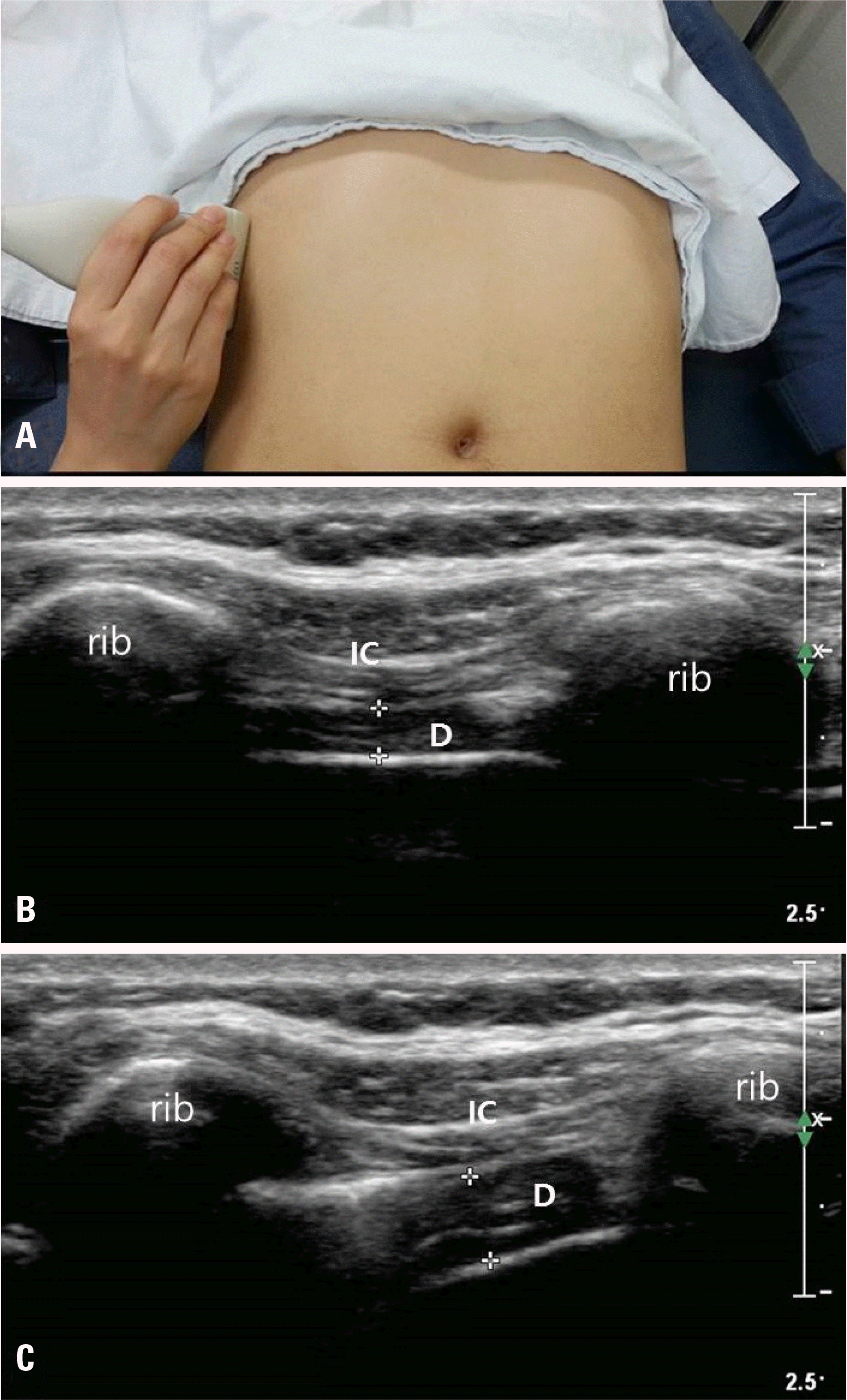초록
Background
Neuromuscular ultrasound can be used to assess the diaphragm. Before it can be used clinically, the reference ranges of diaphragm thickness and contractility must be determined.
Methods
We measured the thickness of the diaphragm and the diaphragmatic thickening fraction (DTF) in 80 healthy volunteers with ultrasound and collected their demographic infor-mation to determine if age, sex, and body mass index (BMI) influence these measures.
Results
The thickness of the diaphragm at resting end expiration was 0.193 ± 0.044 cm on the right side and 0.187 ± 0.039 cm on the left. The DTF was 104.8 ± 50.6% on the right side and 114.9 ± 49.2% on the left. Sex, weight, height, and BMI significantly affected the thickness of the diaphragm, but had little effect on the DTF.
REFERENCES
2.Podgaetz E., Garza-Castillon R Jr., Andrade RS. Best approach and benefit of plication for paralyzed diaphragm. Thorac Surg Clin. 2016. 26:333–346.

4.Sarwal A., Walker FO., Cartwright MS. Neuromuscular ultrasound for evaluation of the diaphragm. Muscle Nerve. 2013. 47:319–329.

6.Chetta A., Rehman AK., Moxham J., Carr DH., Polkey MI. Chest radiography cannot predict diaphragm function. Respir Med. 2005. 99:39–44.

7.Boon AJ., Alsharif KI., Harper CM., Smith J. Ultrasound-guided needle EMG of the diaphragm: technique description and case report. Muscle Nerve. 2008. 38:1623–1626.

8.Boon AJ., Harper CJ., Ghahfarokhi LS., Strommen JA., Watson JC., Sorenson EJ. Two-dimensional ultrasound imaging of the diaphragm: quantitative values in normal subjects. Muscle Nerve. 2013. 47:884–889.

9.Harper CJ., Shahgholi L., Cieslak K., Hellyer NJ., Strommen JA., Boon AJ. Variability in diaphragm motion during normal breathing, assessed with B-mode ultrasound. J Orthop Sports Phys Ther. 2013. 43:927–931.

10.Ueki J., De Bruin PF., Pride NB. In vivo assessment of diaphragm contraction by ultrasound in normal subjects. Thorax. 1995. 50:1157–1161.

11.Gottesman E., McCool FD. Ultrasound evaluation of the paralyzed diaphragm. Am J Respir Crit Care Med. 1997. 155:1570–1574.

12.Baldwin CE., Paratz JD., Bersten AD. Diaphragm and peripheral muscle thickness on ultrasound: intrarater reliability and variabil-ity of a methodology using non-standard recumbent positions. Respirology. 2011. 16:1136–1143.

13.De Bruin PF., Ueki J., Bush A., Khan Y., Watson A., Pride NB. Diaphragm thickness and inspiratory strength in patients with Duchenne muscular dystrophy. Thorax. 1997. 52:472–475.

Fig. 1.
Measurement of diaphragm thickness. (A) The transducer is positioned on the intercostal space in the anterior axillary line. (B) At the end of quiet expiration, the diaphragm is seen as a hypoechoic structure between two hyperechoic fascia bands. (C) At maximal inspiration, the diaphragm is seen ‘peeling away’ from the chest wall. The distance between the two marks (+) is the muscle thickness. D, diaphragm; IC, intercostal muscle.

Table 1.
Normal reference values for diaphragm thickness and the diaphragm thickness fraction (DTF)
Table 2.
Diaphragm thickness and the diaphragm thickness fraction (DTF) according to demographic factors
| DT, resting | DT, maximal inspiration | DTF c | ||||
|---|---|---|---|---|---|---|
| Rt | Lt | Rt | Lt | Rt | Lt | |
| Age, mean (SD) | ||||||
| 3 rd decade | 0.19 (0.04) | 0.18 (0.04) | 0.40 (0.09) | 0.41 (0.11) | 107 (41) | 134 (47) |
| 4 th decade | 0.20 (0.06) | 0.18 (0.04) | 0.38 (0.13) | 0.39 (0.10) | 90 (43) | 115 (54) |
| 5 th decade | 0.19 (0.04) | 0.20 (0.04) | 0.40 (0.13) | 0.42 (0.09) | 106 (48) | 119 (44) |
| 6 th decade | 0.19 (0.03) | 0.19 (0.04) | 0.40 (0.15) | 0.37 (0.09) | 116 (66) | 91 (45) |
| p-value | 0.77 | 0.31 | 0.97 | 0.34 | 0.44 | 0.04 b |
| Sex, mean (SD) | ||||||
| Male | 0.22 (0.05) | 0.21 (0.03) | 0.47 (0.12) | 0.44 (0.10) | 118 (56) | 118 (50) |
| Female | 0.17 (0.03) | 0.17 (0.04) | 0.32 (0.08) | 0.35 (0.08) | 92 (41) | 112 (49) |
| p-value | <0.001 b | <0.001 b | <0.001 b | <0.001 b | 0.02 b | 0.56 |
| Height | ||||||
| CC | 0.659 | 0.567 | 0.512 | 0.340 | 0.071 | –0.137 |
| p-value | <0.001 b | <0.001 b | <0.001 b | <0.001 b | 0.53 | 0.22 |
| p-value a | <0.05 b | 0.15 | 0.16 | 0.99 | 0.48 | 0.38 |
| Weight | ||||||
| CC | 0.596 | 0.454 | 0.540 | 0.380 | 0.164 | 0.013 |
| p-value | <0.001 b | <0.001 b | <0.001 b | <0.001 b | 0.15 | 0.90 |
| p-value a | <0.001 b | <0.05 b | 0.12 | 0.65 | 0.08 | 0.06 |
| BMI | ||||||
| CC | 0.513 | 0.496 | 0.339 | 0.213 | –0.026 | –0.222 |
| p-value | <0.001 b | <0.001 b | <0.05 b | 0.06 | 0.82 | 0.05 |
| p-value a | <0.001 b | <0.05 b | 0.24 | 0.52 | 0.08 | 0.07 |




 PDF
PDF ePub
ePub Citation
Citation Print
Print


 XML Download
XML Download